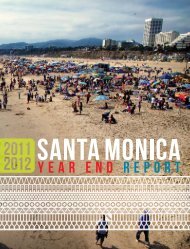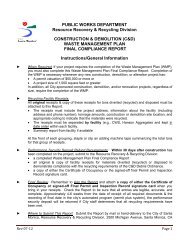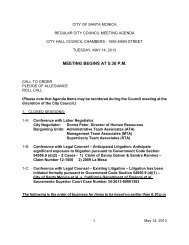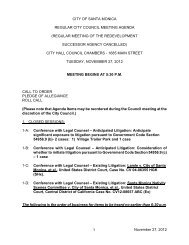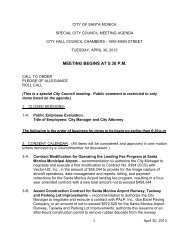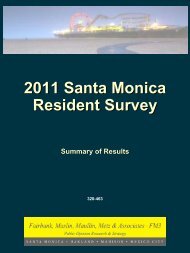Comprehensive Annual Financial Report - City of Santa Monica
Comprehensive Annual Financial Report - City of Santa Monica
Comprehensive Annual Financial Report - City of Santa Monica
Create successful ePaper yourself
Turn your PDF publications into a flip-book with our unique Google optimized e-Paper software.
directors are appointed by the <strong>City</strong> Manager.<br />
The <strong>City</strong> provides a full range <strong>of</strong> services, including police and fire protection, water and wastewater utilities,<br />
street maintenance, public transportation, parking, parks and recreation, planning, and building and safety.<br />
Elementary and secondary education is provided by the <strong>Santa</strong> <strong>Monica</strong> Malibu Unified School District, and<br />
community college education is provided by the <strong>Santa</strong> <strong>Monica</strong> College District. Courts, health and social<br />
services are provided by the County <strong>of</strong> Los Angeles. Gas, electric and telephone services are provided by<br />
private utility companies.<br />
<strong>Financial</strong> data for all funds through which services are provided by the <strong>City</strong> have been included in this report<br />
based on the criteria adopted by GASB.<br />
FINANCIAL CONDITION AND OUTLOOK<br />
Despite a normally resilient economy, <strong>Santa</strong> <strong>Monica</strong> has not been immune to the economic factors at play at<br />
the national and state level. Property transfers have declined to record lows and the local tourism industry has<br />
been impacted. While our sources <strong>of</strong> revenue are diversified, most major tax revenues have declined and are<br />
predicted to decline further in the coming fiscal year. The recession that began in December 2007 has<br />
subsided but economists remain uncertain about the nature and length <strong>of</strong> the recovery.<br />
In spite <strong>of</strong> revenue declines, the <strong>City</strong> ended the fiscal year with a positive operating balance and a record<br />
General Fund Balance <strong>of</strong> nearly $200 million. Proactive fiscal management demonstrated by close<br />
monitoring <strong>of</strong> revenues and mid-year adjustments contributed to this positive result, as well as a transfer <strong>of</strong><br />
unrestricted proceeds from a legal settlement with certain oil companies over MTBE contamination. Large<br />
designated reserves provide flexibility and resources for capital projects, future expenditures, retirement<br />
contribution increases and economic uncertainty; and <strong>Santa</strong> <strong>Monica</strong> continues to be a top destination for<br />
visitors and a high demand location for employers.<br />
In November 2008, <strong>Santa</strong> <strong>Monica</strong> voters affirmed the <strong>City</strong>’s Utility Users Tax ordinance and eliminated the<br />
need for an $8.2 million portion <strong>of</strong> the General Fund balance previously designated as a contingency for the<br />
potential loss <strong>of</strong> the telecommunications portion <strong>of</strong> the tax. This $8.2 million was in turn set aside by the<br />
<strong>City</strong> Council to fund an economic uncertainty reserve to allow the city to respond to the impacts <strong>of</strong> the current<br />
economic turmoil. The adopted Budget for FY 2009-10 anticipates using this reserve as a bridge for the next<br />
two years in order to allow the <strong>City</strong> to make necessary budget adjustments in order to respond to a downturn<br />
in the economy. This bridge provides for a more measured and strategic approach to closing the ongoing<br />
structural shortfall and also allows the <strong>City</strong> to better assess expected ongoing revenue streams as the economy<br />
recovers. As part <strong>of</strong> the FY 2009-10 budget development, departments proposed reductions that will help the<br />
<strong>City</strong> to weather the current economic crisis while mitigating potential service impacts to the community. The<br />
greatest budget reduction was in staffing with the remainder a reduction costs for vehicle replacement,<br />
departmental supplies and contractual and pr<strong>of</strong>essional services. The plan for FY 2010 -11 assumes these<br />
savings will continue. Additionally, a <strong>City</strong>wide hiring freeze will remain in effect until longer term budget<br />
adjustments are implemented.<br />
California’s budget deficit continues to present challenges for the <strong>City</strong>. The FY 2009-10 State budget<br />
included two especially significant revenue provisions affecting the <strong>City</strong>, a $1.9 billion borrowing <strong>of</strong> property<br />
tax funds from local governments under the provisions <strong>of</strong> Proposition 1A and a $2.05 billion seizure <strong>of</strong> local<br />
redevelopment funds. The <strong>City</strong>’s share <strong>of</strong> the property tax borrowing, which would have resulted in reduced<br />
revenues to the <strong>City</strong>’s General Fund, was $3.1 million. However, by reason <strong>of</strong> the <strong>City</strong>’s participation in the<br />
State-sponsored securitization <strong>of</strong> the <strong>City</strong>’s Proposition 1A receivable, the <strong>City</strong> will receive an equivalent<br />
vi





